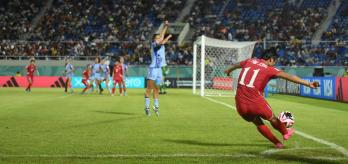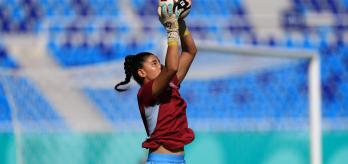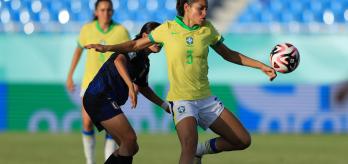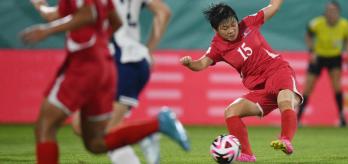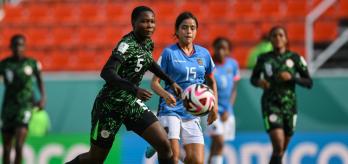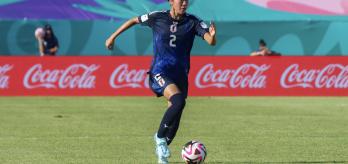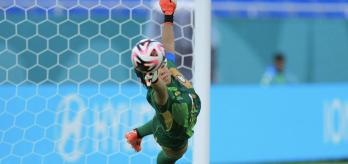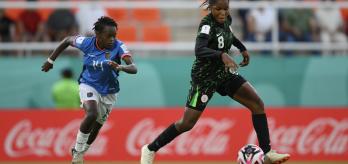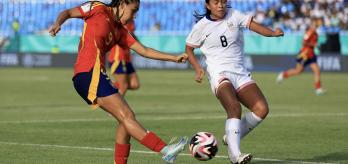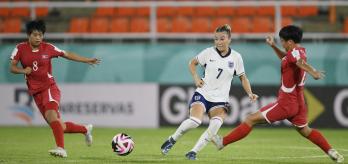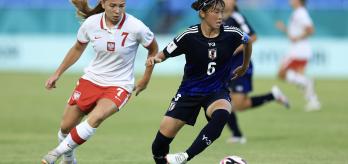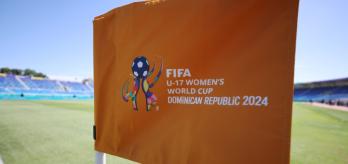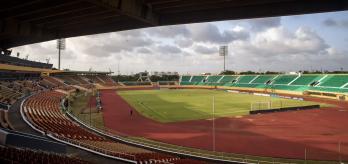It has also become a common tactic for attacking teams to crowd the area around the opposition goalkeeper as they attempt to limit the space and time available for the defending side to respond to the situation. During the FIFA U-17 Women’s World Cup Dominican Republic 2024™, our Technical Study Group (TSG) noted some interesting developments when the actions of goalkeepers in these situations were compared to the FIFA U-17 Women’s World Cup India 2022™.
As can be seen in the graphics below, our review of the data from both competitions revealed that, from corners delivered directly into the penalty area, goalkeepers were completing more aerial control situations during 2024 (70.5%) compared to 2022 (64.3%). In addition, and more notably, they were completing more aerial controls under direct pressure with a 70.5% completion rate in 2024 compared to 57.1% in 2022.
When we examined exactly how goalkeepers were dealing with these crosses, it emerged that they are punching (+7.1%) and claiming (+5.5%) more, while tipping them has reduced (-12.6%) in comparison to India two years ago. According to TSG member Pascal Zuberbühler, this shift indicates an increased level of aggression from goalkeepers at U-17 level.
“Goalkeeper interventions were occurring more frequently in 2024, and we could see how much more assertive they were in these situations. Dealing with crosses from corners is complex for goalkeepers as these situations demand significant game intelligence, decision-making, and timing. You need a good starting position, a solid overview of the situation to see who is in your vicinity or likely to enter it, and you need to read the trajectory of the ball to understand when you can make contact at the highest point. Then you have to decide whether you can claim the ball or if it is better to punch it clear,” he explained.
Claiming the ball
When making the decision to come and claim, the goalkeeper must be certain they will secure the ball, particularly in high-risk situations. Apart from the technical aspects of claiming the ball, the time of the game and scoreline can also influence the decision a goalkeeper makes in these situations. A clean catch means the team has regained possession and this can be very advantageous, but as ‘Zubi’ explains, the goalkeeper must choose the intervention based on the scenario.
“If the goalkeeper decides to claim the ball, they must be absolutely certain that they can catch it securely, especially when they are under pressure from opponents, otherwise getting a strong punch to the ball is a better option. They must have the game intelligence to understand the situation, but their defenders must also understand their roles in terms of protecting the space around their goalkeeper.
“Claiming a ball is mentally and physically demanding. The goalkeeper must be explosive to make decisive attacking steps and generate the elevation needed to claim the ball at its highest possible point above other players. They must have the body strength to maintain a strong posture when in the air, fully extended, and to withstand contact from other players. During this tournament, we saw some outstanding claims from young goalkeepers, and this demonstrates the training they are undertaking to perform so confidently in these challenging situations,” he added.
In the three clips below, Zuberbühler highlights some great examples of aerial claims from direct balls into the penalty area from corners.
In clip 1, Japan’s initial defensive setup before the corner comes in sees four markers assigned to four Poland attackers ahead of the penalty spot, while a defender is working to protect the goalkeeper from the attacker nearby. Japan also have two zonal defenders in the front-post area. As the ball travels in, Mao Fukuda (1) maintains her position and judges the flight of the ball very well, while her nearest defender stays close to the attacking player, ensuring she cannot access the area that her goalkeeper is working in. This gives her goalkeeper the space to take a step towards the point at which she wants to claim the ball. She pushes off her left foot to gain the elevation to claim and brings her right knee up to give her protection while in the air, claiming the ball confidently. The work done by her defenders to ensure their goalkeeper has the space to operate in is very important in this situation.
Clip 2 is taken from the FIFA U-17 Women’s World Cup 2024 final, as Spain goalkeeper Laia López (1) deals with a dangerous inswinging delivery from a Korea DPR corner. She has four defenders working inside the goal area (six-yard box), with two in her vicinity working to protect the space that she will need to operate in. Before the delivery of the ball, Spain have good control of the defensive situation, with all opposition players accounted for. This is a very difficult ball to deal with and if the goalkeeper takes one step backwards, the ball will go into her goal, but she judges the trajectory excellently. In her peripheral vision to her left, she is aware of the incoming attacking player, but she keeps her full focus on the ball and claims it cleanly.
Finally, in clip 3, we see that the USA have brought all ten outfield players back into their penalty area while Korea DPR only have five attacking players in the area when the corner is being taken. In this situation, the delivery is quite favourable for the goalkeeper because the ball is high, and it stays in the air for a little longer, giving Evan O’Steen (21) more time to judge its flight and to time her intervention. She keeps her eyes on the ball the whole time as she takes side steps towards the point at which she claims the ball. She is confident, dominates her area and times her intervention perfectly.
Punching the ball
If a goalkeeper is not certain they can make a clean catch, opting to punch the ball can also be a decisive intervention. When punching, a clean, strong contact with the ball is desirable to generate as much distance as possible when re-directing it away from the penalty area. The physical demands of this intervention are similar to those when claiming the ball, as is the ability to read the trajectory of the ball.
According to Zuberbühler, “Punching the ball clear can be just as effective as catching it. Of course, a clean catch means a turnover in possession, but sometimes it is better to punch clear than to try to claim it in high-risk situations. If you choose to punch the ball, do you punch with your left hand, right hand or both hands? These are important factors, so there is a lot for the goalkeeper to process.”
Below, ‘Zubi’ has selected three high-quality examples of U-17 goalkeepers opting to punch the ball when dealing with corner deliveries direct into the penalty area.
In clip 4, we see that Poland have a well-structured defensive setup in their goal area, while Japan have one attacking player just in front of the goalkeeper, but she is not directly impeding her. The remainder of Japan’s attacking players are preparing to make runs from the edge of the penalty area. In this situation, Julia Woźniak (1) has an open body position, aware of the positioning and potential attack point for those opposition players. This enables her to judge the flight of the ball as it travels towards the back-post area. Since she knows Japan have runners to that area, she doesn’t take any risks, using both hands to punch the ball away from the danger area.
Then, in clip 5, we see Zambia’s goalkeeper, Mwila Chishala Mufunte (18), dealing with a difficult outswinging delivery. With two players defending zonally at the front post, they have one player marking inside the goal area and two further zonal players located between the edge of the goal area (six-yard box) and the penalty spot, with three designated markers among Brazil’s five attacking players. Mufunte knows this will be an outswinger because she is aware it will be a right-footed delivery and judges the trajectory of the ball to the back of her goal area perfectly. She advances bravely into the crowded area to punch the ball clear with a decisive intervention. She never takes her eyes off the ball as it travels and demonstrates her willingness to dominate her area in this challenging situation.
In clip6, we see an excellent goalkeeping intervention from Colombia’s Luisa Agudelo (1) in their match against Korea Republic. In this instance, the delivery is right-footed but instead of swinging in, the ball has a straighter trajectory with a looping element to its height, meaning it stays in the air a little longer. For this reason, the timing of the jump to intervene needs to be delayed and Agudelo judges this very well. She is under the ball as it drops and waits until she knows she can make clean contact. As she jumps, she shows her explosivity by getting genuine height in her leap, making a strong punch to clear the ball while under pressure from an attacking player, who has also achieved good height in her attempt to make contact with the ball. The flight of this ball makes it particularly difficult to deal with but Agudelo’s timing, judgement and explosivity facilitate an important intervention.
Key take-aways
Dealing with crosses from corners is one of the most complex situations that goalkeepers face during games, demanding high levels of game intelligence, decision-making, and physicality. During the FIFA U-17 Women’s World Cup Dominican Republic 2024, it was noted that goalkeepers are becoming more proficient at completing aerial control interventions in general, and when under pressure.
Technical components considered are:
- Starting position
- Judging the trajectory of the ball
- Decision-making (claim, punch or tip the ball)
- First steps
- Physicality
- Courage






